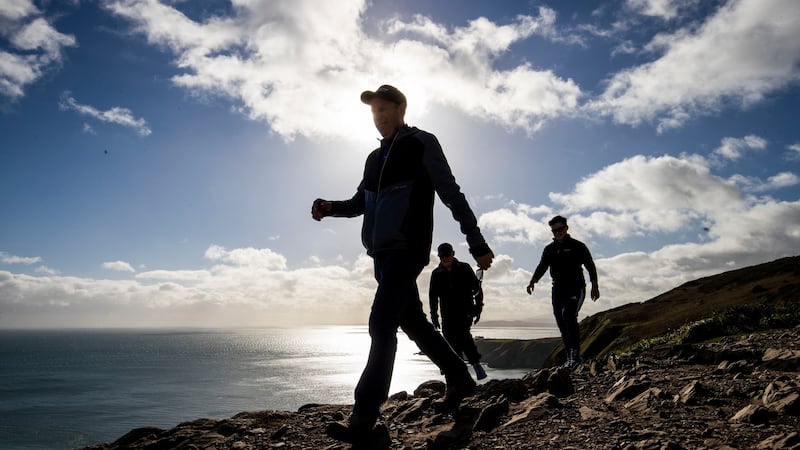Behind the shut doors of his central Dublin shop, Ken Costigan is busier than expected these days, parcelling trekking shoes for shipping to “every small corner of Ireland” as the country experiences a surge in the simple pleasure of walking.
Forced to close during earlier coronavirus restrictions – and now again for six weeks – the co-owner of Great Outdoors noticed during the first lockdown a significant spike in online sales of walking gear.
“Sales had doubled,” he says.
Hospital Report
“And it has just kept going. The kind of gear people wear walking their dog or when out in the park; sales have been really good since May.”
Costigan says his own observations as a keen walker also point to “an awful lot more people out walking”.
Official figures bear out his contention of a nation taking to its feet.
Sport Ireland, the State body charged with promoting sports, commissioned pollsters Ipsos MRBI to carry out a survey of walking habits during three phases since the outbreak of the pandemic.
The first stage was before most early restrictions were imposed, the second covered weeks in March when schools were first shut down, and the third stage covered the “Stay at Home” lockdown imposed from the end of March.
The poll found more people walking regardless of gender, geographic location or income level – up from 65 per cent of the population nationally to 78 per cent.
Some 60 per cent of Dubliners reported walking recreationally before the Covid-19 restrictions. That increased to 75 per cent during the second stage and rose again to 80 per cent during the tightened lockdown.
Elsewhere in Leinster, numbers jumped from 68 per cent to 82 per cent; in Munster from 66 per cent to 76 per cent; with the lowest increase in Connacht/Ulster, from 68 per cent to 71 per cent.
Those aged under 45 were most likely to be walking more, as were higher income middle class earners (up from 67 per cent to 87 per cent) compared with lower income earners (up from 64 per cent to 71 per cent).
The shift was against a backdrop of fewer people engaging in sporting activity, but that drop-off was less pronounced than the increase in walking.
The poll also found a significant drop in the number of “inactive” people, who do neither sport nor walking – down from 22 per cent for March/April last year to 14 per cent for the same period this year.
The trend is heartening for Shane O’Mara, professor of experimental brain research at Trinity College Dublin, who wrote a book on the benefits of walking.
While walking is not a panacea for all our woes and ailments, it could be “for a fair few of them”, he suggests.
Prof O’Mara says humans evolved as social walkers – “We walked out of Africa to conquer the world and we did it together in groups, in families and in tribes.” Studies show the sound of footfall lights up the area of the brain associated with social activity.
People who walk more tend to be more connected with friends and neighbours, tend to have greater levels of psychological wellbeing
Pacing his hallway while talking on the phone, Prof O’Mara describes walking as a “commonplace miracle” which produces molecules called myokines, which diffuse all around the body, building resilience in both the brain and body.
People who walk more are much less likely to have non-communicable diseases, such as heart conditions, or affective disorders such as depression and it is also a good boost to creativity and memory.
“It is also good for our neighbourhoods. People who walk more tend to be more connected with friends and neighbours, tend to have greater levels of psychological wellbeing,” says Prof O’Mara.
“So it is good for society at large and that comes back to this idea that we have evolved as social walkers.”
Making us more resilient, focused and healthier, he suggests the surge in walking is acting as a natural human response to the imposition of lockdowns.
Conversely, that social connection through walking has also taken a hit during the restrictions.
Neighbourhood walking groups countrywide are reporting a steep fall-off in attendance as people are warned to reduce their contacts with others.
Keith Kelly set up Walks and Talks in Dublin’s Ballyfermot two years ago. It quickly swelled to 70 members, mainly women aged 50 years and over.
“It just went kaput when Covid came. It went into full shutdown,” he says.
There was an attempt to get it going again in the summer, but nobody turned up.
“It’s catch-22,” says Kelly. “A lot of the members are classed as vulnerable but they are the ones who need the walking group the most, they don’t have anyone else to walk with.”

Kelly would like to see engagement from authorities – including formal training – to get people back walking in a safe, socially distanced way.
“There is a national fear now of meeting in groups, and older people are feeling it most,” he adds.
Jason King, programme manager of Get Ireland Walking, which supports hundreds of informal neighbourhood walking groups, says under the current lockdown they “have all been put on hold”.
“They are a social outlet for many, but what can we do? The restrictions have put the kibosh on things,” he says, advising members to stay in touch through the likes of WhatsApp groups.
“Hopefully, when there is a pull back on this, we can get back out with smaller numbers in a safe way,” he says.









